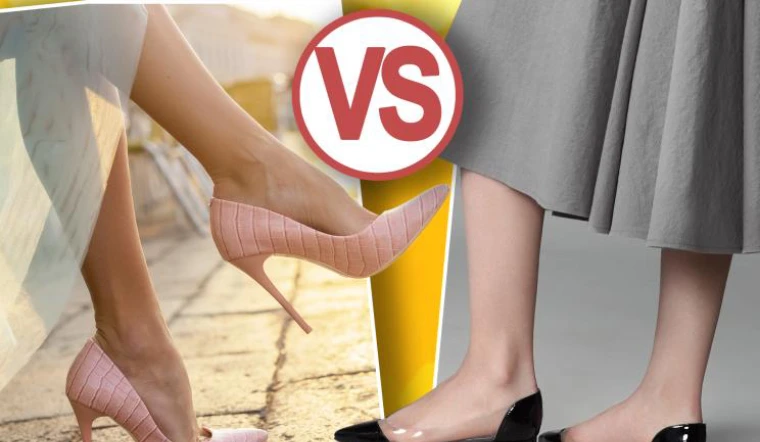It’s the end of a long day, and you finally slip off your towering high heels, exchanging them for the soft embrace of your favorite slippers. The relief is instant, and a question inevitably comes to mind: Why did I wear those heels in the first place? Whether you’re gearing up for a night out or just relaxing at home, the debate between high heels vs slippers is one that women (and some men!) know all too well. While high heels offer style, confidence, and height, slippers represent ultimate comfort and relaxation. But is there a clear winner between the two?
As more people reconsider their everyday footwear choices—especially in a world adapting to hybrid work environments—the tug-of-war between fashion and comfort is real. This article will dive into the high heels vs. slippers debate with a mix of stats, trends, and practical insights.
High Heels: The Power of Elevation
There’s no denying the appeal of high heels. They’re often associated with confidence, elegance, and power, elevating not just height but also an outfit’s overall look. Historically, high heels have been a symbol of status and fashion. According to a 2023 survey by Statista, 62% of women aged 25-45 report that they wear high heels at least once a week, despite acknowledging the discomfort that can come with them.
However, comfort is becoming a larger part of the conversation. The American Podiatric Medical Association (APMA) reports that 71% of women who wear high heels regularly experience foot pain. The association also states that wearing high heels over long periods can contribute to long-term health issues, including bunions, ankle injuries, and lower back pain. Over 20% of foot-related injuries among women can be attributed to wearing high heels, according to the National Institute for Health.
Slippers: The Comfort Champion
On the other end of the spectrum, slippers embody everything high heels are not—comfort, ease, and a more relaxed vibe. With the increase in work-from-home setups and more casual approaches to fashion, slippers have become a staple in many households. According to a report by Grand View Research, the global slipper market was valued at $8.6 billion in 2022 and is expected to grow at a rate of 5.5% annually through 2028.
Slippers aren’t just for lounging, either. Brands are increasingly creating stylish and supportive options, meaning that comfort doesn’t have to sacrifice style. A study by Mintel found that 48% of consumers prioritize comfort in footwear purchases, reflecting a broader shift toward health and well-being over mere aesthetics. This rise in demand for comfortable, yet presentable, footwear is reshaping the market.
Fashion vs. Function: What Consumers Are Saying
In a consumer survey conducted by YouGov, 53% of respondents said they value comfort over style when it comes to everyday footwear. Yet, 38% still believe that high heels are essential for formal occasions, suggesting that while comfort is becoming more important, high heels continue to have their place in specific social contexts.
Interestingly, the shift toward comfort doesn’t only apply to older generations. Millennials and Gen Z consumers are also playing a significant role in this change. A study by Fashion Monitor reveals that 67% of younger consumers are opting for more practical and comfortable footwear, with slippers and casual shoes making up a significant portion of their purchases.
The Health Angle: Impact on Feet and Posture
The health implications of wearing high heels vs. slippers are stark. High heels, while fashionable, alter the natural alignment of your body. They put extra pressure on your toes and the balls of your feet, leading to issues like blisters, hammertoes, and even plantar fasciitis. According to a study published by the Journal of Foot and Ankle Research, women who wear high heels regularly are at a 23% greater risk of developing musculoskeletal disorders over time.
In contrast, slippers, particularly those with arch support, can help alleviate foot pain and improve posture. The APMA suggests wearing supportive, cushioned footwear at home to prevent flat feet and reduce the strain on joints, especially for people who spend long hours standing or walking. Slippers that offer proper support can even reduce the risk of conditions like arthritis and tendonitis.
The Verdict: A Balancing Act
Ultimately, the choice between high heels and slippers depends on the situation. High heels will always have a place in formal settings, where style and sophistication take precedence. However, the increasing focus on comfort, health, and well-being makes slippers—and other comfortable footwear options—a more popular choice for everyday wear.
As fashion evolves, there’s a growing movement toward hybrid footwear that blends the best of both worlds. Brands are now designing shoes that offer the elegance of high heels with the comfort of slippers, creating stylish yet supportive options for every occasion.
Conclusion
In the high heels vs. slippers debate, there is no definitive winner. It’s about finding the right balance between style and comfort, understanding the occasion, and prioritizing your foot health. While high heels may offer a confidence boost for that big meeting or event, nothing quite compares to the cozy feeling of slipping into a comfortable pair of slippers at the end of the day.




